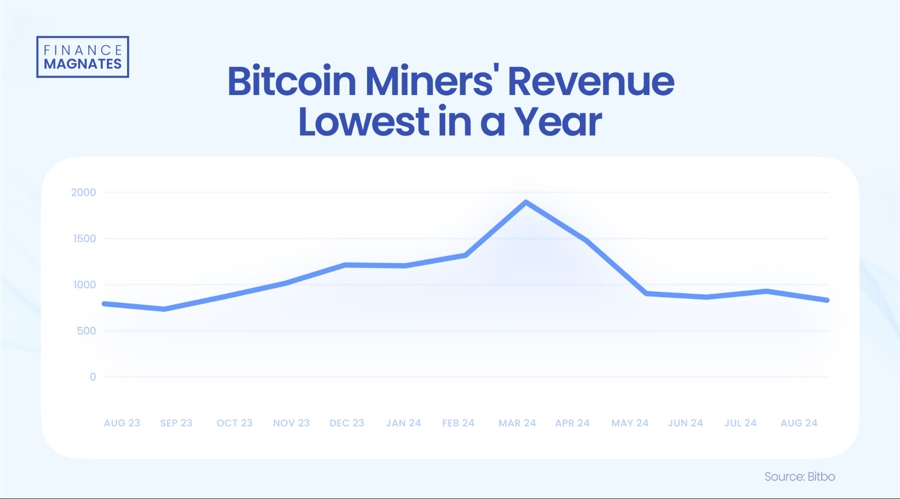Bitcoin (BTC) mining is increasingly competitive, but miners see diminished revenues from fees. September saw the lowest inflows for miners for the whole of 2024, revealing new post-halving challenges.
Bitcoin (BTC) miners received close to $816M in block rewards for the month of September, also noting a significant slowdown of fees. Transaction premiums were a successful addition to revenues, reaching up to $1.7B in April.
The September revenue crunch affected corporate miners from the US market. Core Scientific, one of the industry leaders, is the only stock on the rise, though without recognizing financial results from Q3. Based on the past 12 months, Core Scientific is also the leader in terms of revenues, reaching $570M.
Marathon Digital Holdings (MARA), however, has higher retained earnings of $450M for the past year. Marathon Digital also has the most profitable operating margins, along with Hut 8. Overall, Bitcoin mining revenues affect 24 publicly traded US companies, sending signals to mainstream investors and potential ETF buyers.
Bitcoin loses boost from Ordinals and Runes
Bitcoin lost the boost fees from inscribing Ordinals and from Runes transfers. The long-awaited Bitcoin DeFi summer did not materialize, and BRC-20 tokens hardly took off. Block fees for faster transactions moved down to levels not seen since Q1 2023, before the introduction of Bitcoin-based tokens.

The creation of L2 chains and DeFi was also delayed, despite the attempted launches of new projects. The Bitcoin network also switched to only around 14% in Rune fees, with more than 85% covered by regular transaction fees. Runes also failed to take off, with the exception of DOG and a handful of memes, failing to compete with the more active Ethereum and Solana tokens.
The diminished block reward set expectations that Bitcoin could continue to incentivize miners, mostly through fees. However, on-chain activity also slowed down, as most coins are held for their long-term value.
Confirmed daily transactions are also not predictable. On some days, the activity rises to nearly 800K active wallets and more than 700K transactions. However, on other days, Bitcoin activity returns to its 2022 bear market baseline. BTC usage has slowed down as a means of payment, with users preferring stablecoins. For some, BTC is only suitable as a collateral or held in cold storage, to avoid the risk of loss.
Bitcoin active addresses often return to levels not seen since the 2017 bull market. While professional and whale wallets mopped up BTC, retail crypto owners have switched to other assets for everyday transfers.
Bitcoin mining slows down in September
Mining activity is still close to its higher range, but September saw some of the hashrate shut down. The Bitcoin network decreased its activity from 756 EH/s to 636 EH/s, down by 26% in the past four weeks.
A small fraction of the hashrate moved to Bitcoin Cash (BCH), which was also occasionally more profitable to mine. The Bitcoin Cash hashrate is more volatile, but mops up some of the spare capacity of pools.
The withdrawal of mining power, however, may be strategic. The competitive rise in mining in 2024 also pushed up the mining difficulty levels. As of September 26, the difficulty was reset downward, potentially giving miners another two weeks with easier block discovery. Connecting more hashing power during lower difficulty periods may help with solving additional blocks.
The Bitcoin network difficulty is also forming a chart plateau after years of climbing, as mining power is hitting barriers to growth. New mining operations require specialized facilities to scale, and small-scale mining faces the challenges of switching to the newest Bitmain mining rigs.
For now, Bitcoin miners also retain a little above 2M coins, becoming the biggest body of holders. With BTC still in the $60,000 to $65,000 range, some operations may have their expenses covered, especially if holding coins from previous mining periods. However, new mining operations may require a much higher breakeven price for BTC.
Bitcoin mining is still shifting to US-based operations, mostly tied to big data centers. Foundry USA and ViaBTC make up more than 40% of all mining activity worldwide. The Bitcoin network is supported by 12,462 nodes, though at some points, nodes reached 20K worldwide. Most of the nodes also depend on data centers, and the majority are distributed in the USA and Europe.
Cryptopolitan reporting by Hristina Vasileva





